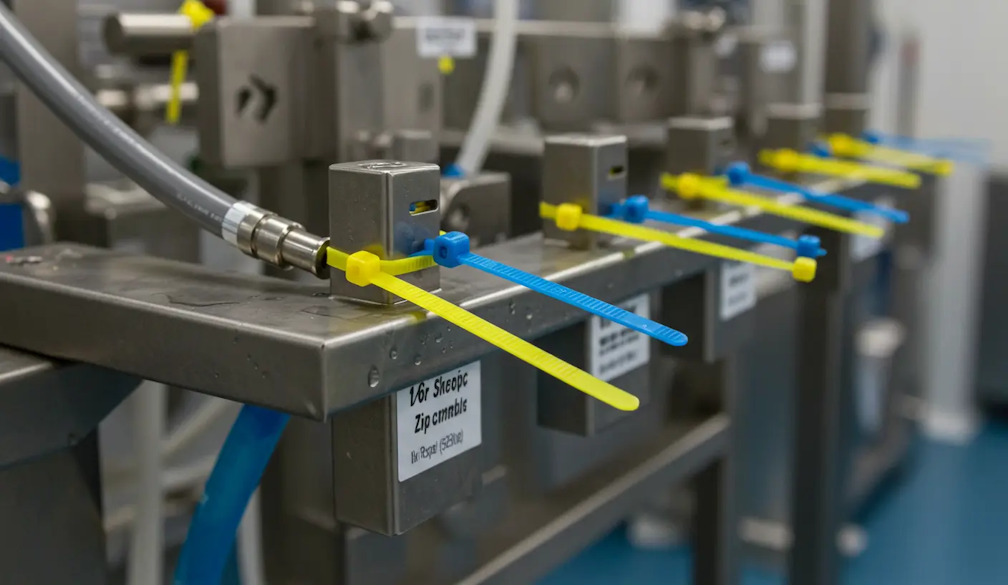How to Choose the Right Zip Ties for Food Processing and Packaging

High safety and hygienic standards must be upheld in the food processing and packaging sector. An often-overlooked component in this process is the selection of the right zip ties, also known as cable ties. These tiny fasteners are important for organizing cables, securing equipment, and even sealing packaging. Choosing the right zip ties ensures not only operational efficiency but also compliance with food safety regulations.
Understanding Zip Tie Materials
Various materials are used in manufacturing zip ties, each offering different properties ideal for specific applications:
- Nylon 6/6: Nylon is a popular material that is renowned for its durability and strength. Standard nylon zip ties are versatile and used in various industries. Making sure the nylon used in food processing is FDA-approved for direct food contact is crucial, though.
- Metal-Detectable Nylon: These metal detectable zip ties are iron infused with metal particles, which makes them detectable by standard metal detection systems. Because any broken pieces can be quickly identified and removed, this feature is crucial for preventing contamination in food processing environments.
- Stainless Steel: Stainless steel offers superior strength and resistance to extreme temperatures and chemicals; stainless steel zip ties are suitable for harsh environments. In addition, they can detect metal, which adds an extra degree of protection against contamination.
What Are Food-Grade Zip Ties?
Food-grade zip ties are specifically designed to be used in surroundings where they might come into direct or indirect contact with food products. To be classified as food grade, these zip ties must meet certain criteria:
- Material Compliance: Made from materials that meet food safety standards, like stainless steel or nylon with FDA (Food and Drug Administration) approval.
- Detectability: The ability to identify and eliminate any fragments during processing by applying metal or X-ray detectable properties.
Importance of Zip Ties in Food Processing and Packaging
The selection of appropriate zip ties is vital for several reasons:
- Preventing Contamination: Any accidental pieces can be promptly located and removed by using zip ties that are either dyed or metal-detectable.
- Compliance with Regulations: It is essential to follow food safety standards, such as those set by the FDA (U.S. Food and Drug Administration). Maintaining compliance and averting possible legal problems are made easier by selecting the appropriate zip ties.
- Operational Efficiency: Selecting the right zip ties enhances the organization of cables and equipment, which reduces the risk of accidents and improves workflow efficiency.
Common Uses of Zip Ties in the Industry
In food processing and packaging, zip ties are utilized in various applications:
- Securing Equipment: Tightening parts and components to guarantee that machinery runs smoothly and is free of loose parts that could contaminate it or cause it to malfunction.
- Organizing Cables: It helps to organize and manage cables to prevent entanglement, which can cause equipment malfunctions or safety hazards.
- Sealing Bags and Packaging: To preserve product freshness and avoid contamination, ensure that packaging is tightly closed.
- Labeling and Identification: Integrated labels on certain food-grade zip ties aid in batch identification and product classification during processing.
Factors to Consider When Choosing Zip Ties
When selecting zip ties for food processing and packaging, consider the following factors:
- Material: Verify that the substance conforms with food safety laws and is appropriate for the intended use.
- Temperature Resistance: Select zip ties that can handle the operating temperatures of the environment, especially if working in areas with extreme heat or cold.
- Chemical Resistance: To avoid deterioration in settings where chemicals are used for processing or cleaning, choose zip ties that are resistant to these substances.
- Detectability: To improve security and avoid contamination, use metal-detectable zip ties.
- Tensile Strength: Make sure the zip ties have adequate strength to hold the items securely without breaking.
- Size and Length: Zip ties should be the proper length and width to secure objects without being too tight or too loose.
Food Safety Regulations and Compliance
Zip ties used in processing and packaging must meet regulatory standards to ensure food safety. Here are some key organizations that provide guidelines for compliance:
- The FDA (U.S. Food and Drug Administration) sets rules for materials that come into contact with food and ensures that safety standards are met.
- The U.S. Department of Agriculture (USDA) regulates food processing safety practices to lower the risk of contamination.
- Hazard Analysis and Critical Control Points, or HACCP, is a management system that guarantees food safety hazards are minimized during the entire processing cycle.
Best Practices for Using Zip Ties in Food Processing
To maximize the effectiveness of zip ties in food processing and packaging, consider these best practices:
- Regular Inspection: Conduct routine checks to ensure that zip ties are intact and functioning properly.
- Use Premium, Approved Zip Ties: Always choose zip ties that meet industry standards and are food-grade.
- Dispose of Broken or Worn-Out Zip Ties: Replace damaged zip ties immediately to avoid any risks.
- Maintain Appropriate Storage Conditions: To maximize their effectiveness, keep zip ties in a dry, clean environment.
Selecting the right zip ties is an essential aspect of maintaining safety, compliance, and efficiency in food processing and packaging operations. You can make decisions that maintain the highest standards of food safety by being aware of the various materials with their characteristics alongside the particular requirements of your environment.
Businesses and consumers can be protected from potential risks by choosing the appropriate material, adhering to best practices when handling it, and ensuring that food safety regulations are followed. Always choose dependable, premium products made for performance and safety when sourcing zip ties for food-related applications.









